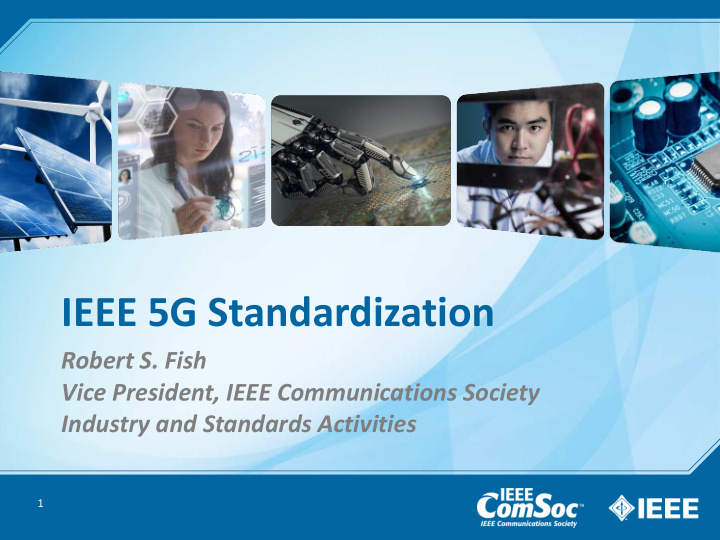



IEEE 5G Standardization Robert S. Fish Vice President, IEEE Communications Society Industry and Standards Activities 1
IEEE ≥5G Vision • IEEE, like many other organizations, believes that 5G ecosystem is rather large and will cover many different areas: Not only an evolution of LTE • New services, new technologies, new spectrum (>6 GHz), new • industries, new business models Multi connectivity across bands & technologies (carrier • aggregation with integrated MAC across sub- 6GHz & above 6GHz, 802.X and macro cells (legacy) “Rethinking” of fundamental areas used in previous ‘Gs’ (cell • architectures, antennas, core networks, etc) (Is it appropriate to continue to use the word “generation” ?) 2
The IEEE ≥5G Hyperplane Speed: >10 Gb/s è Tb/s Massive Content Massive Sensing 1b/s over 10 years using an AAA battery Massive Control Response: 1 ms 3
IEEE Standards Development Process encompasses from early technology research stage to final published standard Research Group (RG) ¾ Identifies and addresses research issues that need to be solved on the way to standardization of technology ¾ Output - vision documents, research reports, white papers, proposal for SG Study Group (SG) ¾ Outlines the scope of a standards development activity in a 3-6 month project ¾ Output – Project Authorization Request (PAR) for WG Working Group (WG) ¾ Solicits technical contributions and writes a standards document ¾ Output – IEEE Standard! 4
Two Types of Standards Participation Individual method • Participants are “individuals”: i.e., people • Individuals represent themselves • Each individual participant has one vote • Ballot groups are made up of a minimum of 10 individuals • Ballot group participants must be IEEE-SA individual members Entity (Corporate) method • Participants are “entities,” i.e., companies, universities, government bodies, etc. • Designated representative and alternate represent the entity • Each entity has one vote • Standards project initiation requires 3 entities to commit to membership and payment of appropriate dues • Entity sends representatives to participate in standards development meetings
IEEE: Standards and Global Collaboration for 5G IEEE provides a complete, end-to-end, collaborative framework today for accelerating the realization of 5G and its revolutionary use cases tomorrow. IEEE 802.11 standard supported by almost any mobile device in the market today Mobile Edge Cloud brings SDN/NFV frameworks and data path programmability to the proximity of end users WiFi IEEE 1914/1904 as key enablers for service differentiation Open flexible, efficient and scalable packet-based fronthaul NGFI transport networks MEC IEEE 1918 SoftRAN is to create a SD RAN flexible enough to non/mission-critical applications (e.g. manufacturing, transportation, IEEE SoftRAN Tactile control applications with the wireline centric healthcare, mobility, edutainment, events) Internet concepts of “fog” in a SD-controller +Fog IEEE 11073 AR provides a global platform for eHealth stakeholders eHealth IEEE P1589/P1587.6/P1857.9/P3333.2.4 Industry Connections the integration of computer-generated sensory content with IoT the physical world IEEE P2413 / 1471 / 42010 6
IEEE ≥5G Standards Track • Track Leaders are Alex Gelman and Paul Nikolich Managing portfolio of activities including: • New projects • Workshops for needs definition and connection with technology developers • Roundtable program for industry leaders • Engagement with SDOs and other external organizations 7
Call to Action Solicit Ideas for Standards Activities • Call for Participation by all Societies • Call for Collaboration • 8
9
More recommend